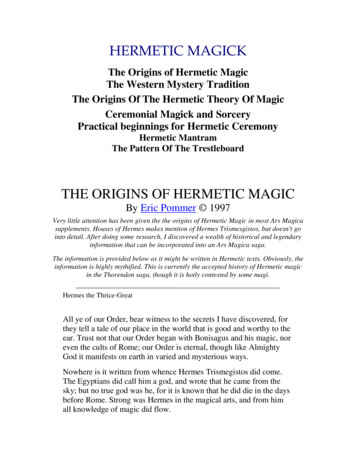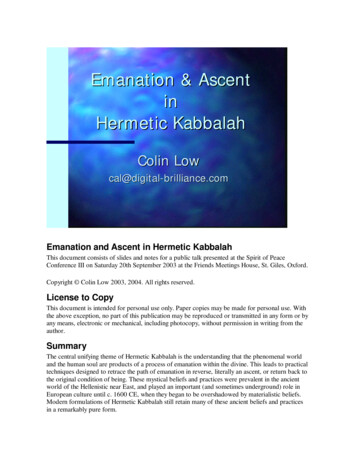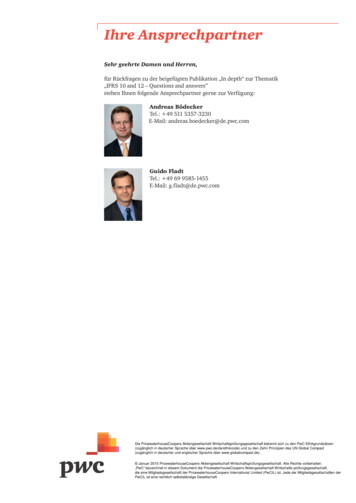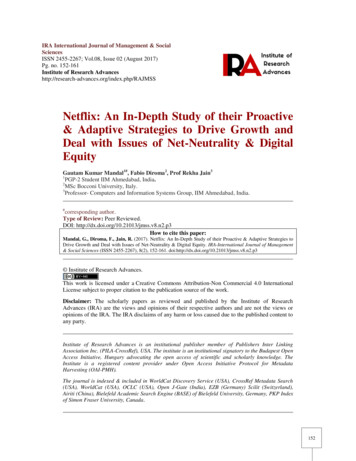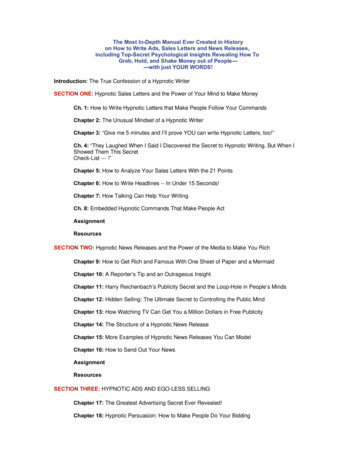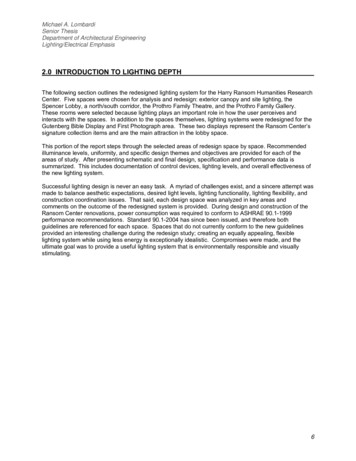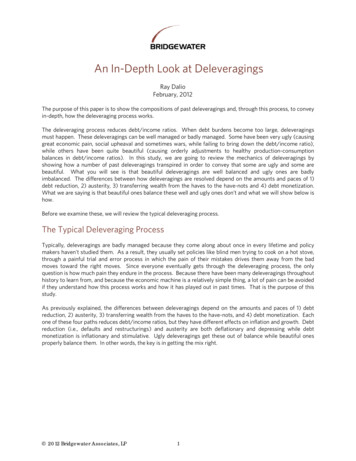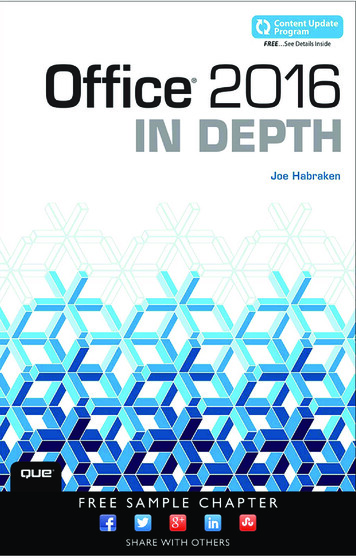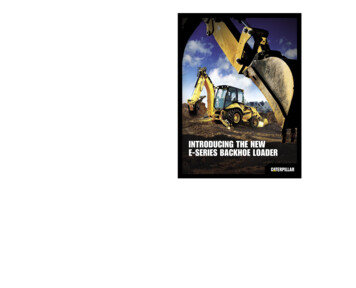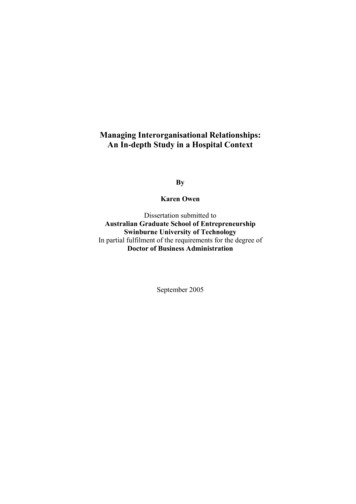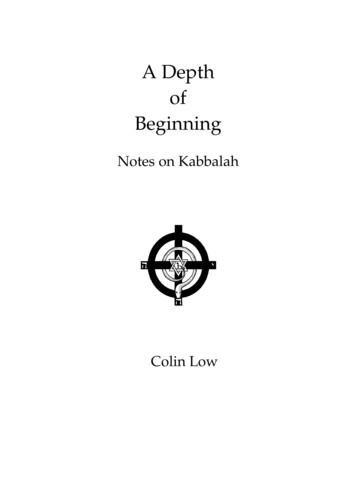
Transcription
A DepthofBeginningNotes on KabbalahColin Low
Copyright Colin Low 2001. All rights reserved.License to CopyThis publication is intended for personal use only. Paper copies may be made for personal use.With the above exception, no part of this publication may be reproduced or transmitted in any form or by any means, electronic or mechanical, including photocopy, without permission in writing from the author. Reviewers may quoted brief passages.Why a free book?The WWW would not have evolved without the extraordinary voluntary labour ofthousands of willing individuals. The Apache WWW server (www.apache.com) is, atthe time of writing, the most popular WWW server software, and it is free for anyoneto use. It often runs on the free Linux operating system, and the two together providethe backbone of the WWW.The immense quantity of useful information and opinion available on the WWW is, inmost cases, provided freely, for the general good of all.Sharing gives us power over our own lives. No person can control a thing when it isfreely available to all. Sharing is a basic human impulse that binds people together.When we share knowledge, skills, experience, and wisdom, it costs us nothing but ourtime, and often leaves us richer than we were.Colin Low, 8th. May 2001Email: cal@digital-brilliance.com
ContentsPrefaceiIntroduction1The Tree of Life5The Pillars & The Lightning Flash 13Sephirothic Correspondences 19The Sephiroth29MalkhutYesodHod & NetzachTipheretGevurah and ChesedDaat and the AbyssBinah, Chokhmah, KeterThe Letters & the PathsThe LettersThe PathsThe Tarot and the TreeThe Four WorldsAtzilut - EmanationBriah - CreationYetzirah - FormationAssiah - MakingThe Four Worlds & the TreeThe SoulsThe Great Work2934404952586371718091107107108109110110113117
Notes on KabbalahThe KlippotPractical Kabbalah121125Initiation127Ritual131Essential Ritual Steps134Using the Sephiroth in Ritual138Suggestions for a Malkhut Ritual 140Other Practical Work141In ConclusionReferences143145
PrefacePrefaceplexity that is utterly intimidating and alienating. There is so much to know.My primary motivation is to learn at firsthand. It is important to learn what other peoplehave learned, but too many people have livedand died for me to learn more than a small fraction of what they have learned. There is a prodigious supply of information, facts, opinions,theories, suppositions, and doctrines, but thewisdom needed to sort through the mountain oftrash in the hope of finding a gold nugget is notsupplied.Kabbalah is part of a long tradition of learningabout the human condition that devotes asmuch time to the heart as to the head. The headcan be catered for en-masse - this is what schoolsand universities do - but the heart is alwaysintensely personal. The head can be taught inlectures and instructed from books, but theheart has to live each experience from theinside.Kabbalah comes from a time when peoplelived less in their heads. Kabbalah has beenpractised since Crusaders were riding to theHoly Land in the early Middle Ages, and itsunderpinnings go back another fifteen hundredyears to a time when Rome was a one-chariottown on the banks of the Tiber. There are elements that date from a time when Jews were living in Babylon in the time of the Assyrian kings,and there are borrowings, buried deep within,that go back as far as Sumer and Akkad fivethousand years ago.Kabbalah is capable of touching the soul in away that very few things can. It contains muchthat went out of fashion two hundred years agowhen it seemed that human reason could provide answers to all meaningful questions. It contains much that has been actively suppressed byestablished religions - and even Judaism hasgone through phases of trying to limit the influence and accessibility of Kabbalah. Kabbalahbrings the subjective and personal element backto learning (hence attempts to suppress it).Unlike science, which studies the natural worldin a way which factors out the subjectivity ofThe domestic cat is a curious creature. Anyone who has lived with a cat will have becomeaccustomed to finding the creature on top of thewardrobe, in the attic, beneath the bed, underthe floorboards, and inside each and every cardboard box that appears in the home.Human beings are curious creatures too,every bit as curious as cats, and differ only inbeing less fascinated by the interiors of emptycardboard boxes. For many people the urge toexplore is as vital as eating, drinking and sleeping.Kabbalah is part of an ancient tradition ofexploration. The domain of exploration is thehuman condition. For some people the experience of living in the world is not enough;because we are self-conscious we can observeourselves in the process of living, and we canobserve ourselves observing ourselves, andimmersed in this introspective hall-of-mirrors,people have attempted to find meaning andmake of sense of it. Morality, ethics, metaphysics, theology, science and mysticism are consequences of a long tradition that places humanexistence inside a larger framework. The truth,as Chris Carter observes, is out there.The urge to explore is as strong today as itever was. It is an individual impulse that cannotbe satisfied gratuitously through books or television. For some people the need to explore thehuman condition is urgent and instinctive. andpersonal. It is the personal element that distinguishes received knowledge from first-handexperience, and it is the root of wisdom. Shouldyou live a moral life because you wereinstructed in morality, or can you find an innerwellspring of morality? Can we ground ourlives in a context that is not completely arbitrary? Is there a home for our hearts that doesnot insult our intelligence?We live in a deeply confused age. A plethoraof full-time professional experts in every subjecthas disenfranchised the majority of people fromgenuine inquiry. Pick up a book on any subject,work through its references into the heart of thesubject, and you will discover a world of com-i
Notes on Kabbalahdo not do this and become trapped in the past,then it becomes a dead thing, an historical curiousity, as was virtually the case within Judaismby the nineteenth century.These notes were written with that intention:to present one view of Kabbalah as it is currently practised, so that people who are interested in Kabbalah and want to learn more aboutit are not limited to texts written hundreds orthousands of years ago, or for that matter, modern texts written about texts written hundredsor thousands of years ago. For this reason thesenotes acknowledge the past, but they do notdefer to it. There are many adequate texts forthose who wish to understand Kabbalah as itwas practised in the past.These notes have another purpose. The majority of people who are drawn towards Kabbalahare not historians; they are people who want toknow enough about it to decide whether theyshould use it as part of their own personalexploration into the condition of being human.These notes may be brief, but there is enoughinformation not only to make that decision, butalso to move from theory into practice.I should emphasise that what I present here isone interpretation of Kabbalah out of many. Ileave it to others to present their own variantsand I make no apology if the material is biasedtowards a particular point of view. It is easy,when looking at history from a great distance,to see homogeneity where there was none, andwhen looking at a tradition as long-lived andcomplex as Kabbalah there is a temptation toover-simplify and create for the modern readerthe fiction of an homogeneous, monolithic andinternally consistent tradition called ‘The Kabbalah’. There never was such a thing. The variety of viewpoints, interpretations and practiceswas (and still is) bewildering.human consciousness, Kabbalah takes ‘consciousness-acting-in-the-world’ to be a legitimate field of study, and the world of theKabbalist extends beyond the world of naturalscience to include a larger world of direct mystical apprehension. It includes God.From the point of view of Enlightenmentrationality, as embodied by thinkers such asDavid Hume and Immanual Kant, Kabbalah is areversion to a discredited metaphysical view ofexistence that projects human values onto a universe that is utterly alien to human values.From the point of view of a modern Kabbalist,Hume and Kant are just as dated; the astounding success of modern physical theories, particularly quantum mechanics and generalrelativity, shows that human beings do indeedhave a deep and penetrating understanding ofthe natural world through the medium of mathematics, just as Plato proposed two and a halfthousand years ago. We reason about the natural world and create exceedingly complex technologies on the basis of that reasoning. Ourminds can function as a simulacrum of the external world. The Kabbalistic doctrine that thehuman being is a microcosm, a perfect miniature simulation of the world at large, containsmore than a grain of truth - it is at the heart ofmodern epistemology.What does this book propose to achieve?What are its goals?If a chemist from the twentieth century couldstep into a time-machine and go back two-hundred years, he or she would feel a kinship withthe chemists of that period. The glass apparatuswould be cruder, the chemicals less refined, andthere would be considerable differences in terminology, underlying theory, and laboratoryprocedures, but a chemist today still sharesmuch in common with the chemists of the past.However, despite this kinship, chemists havenot been trapped in the past, and the subject as itis studied today is very different from the chemistry of two hundred years ago.Kabbalah has existed for nine hundred years,and like any living discipline it has evolvedthrough time, and it continues to evolve. Oneaspect of this evolution is that it is necessary forliving Kabbalists to present what they understand by Kabbalah so that Kabbalah itself continues to live and continues to retain itsusefulness to each new generation. If KabbalistsA version of these notes was published originally on the Internet over the period 1990-1992,and ASCII versions of the text can be found on anumber of Internet and bulletin board servers.This version has been completely revised andgreatly extended.I would like to thank M.S. and the T.S.H.U. forall the fun.And the title? It comes from the Sepher Yetzirah:ii
Preface“Ten sephirot of nothingness: Their measure is ten which have no end. A depth ofbeginning, a depth of end .”Colin Low 2001iii
Notes on Kabbalahiv
Introduction1Introductionchanting, prayer, posture - to induce trancestates in which they fought their way past terrible seals and guards to reach an ecstatic state inwhich they “saw God”. Documents such as theGreater Hekhalot describe the heavenly halls thatmust be negotiated to reach the throne of God,and provide clues as to how to pass the variousguardian spirits.A highly influential document, the SepherYetzirah, or “Book of Formation”, was writtenduring the earlier part of this period, probablyduring the late Roman empire, and may haveoriginated in Palestine. It is an extremely terseand enigmatic document that has been the subject of many commentaries since the earliesttimes. It appears to be theurgic. It describes howGod made the world using numbers and letters,and implies that a person can acquire some ofthe divine creative power by understandingnumbers and letters.By the early Middle Ages more theosophicaldevelopments had taken place, chiefly adescription of “processes” within God, and thedevelopment of an esoteric view of creation as aprocess in which God manifests in a series ofemanations, or sephiroth. This doctrine of thesephiroth can be found in a rudimentary formin the Sepher Yetzirah, but by the time of the publication of the book Bahir in the 12th. century CEit had reached a form not too different from theform it takes today. The doctrine of sephirothicemanation and the use of the word “Kabbalah”as a description for a particular mystical tradition is believed to come from Provence in thesouth of France, from the school of Isaac theBlind, who is widely credited with being “thefather of Kabbalah”.A motive behind the development of the doctrine of emanation can be found in the questions:“If God made the world, then what is theworld if it is not God?”“If the world is God, then why is it imperfect?”The word “Kabbalah” is derived from a rootwhich means “to receive or accept” and is oftenused synonymously with the word “tradition”.There are many alternative spellings of theword, the two most popular being Kabbalahand Qabalah, but Cabala, Qaballah, Qabala,Kaballah (and so on ad nauseam) are also seen.The choice of spelling in these Notes was madeas a result of a poll of the books on my bookcase, and it should not be taken as highly significant.If Kabbalah means “tradition”, then historically the core of the tradition was the attempt topenetrate the inner meaning of the Bible, whichwas taken to be the literal (but heavily veiled)word of God.The act of reading sacred texts, such as theBible (Tanakh) and Talmud, is a vital activity inJudaism. Torah scholars were and are respectedand admired as leaders of their communities.These documents are seen as having an almostholographic complexity, and rather than havinga single agreed meaning, they were scrutinisedand referred to in order to yield new meaningsto deal with every kind of situation. Vast commentaries were written and referred to. Ingenious interpretations and insights wereaccumulated, and often printed around the textof the Bible so that it becomes a kind of earlyhypertext.In these circumstances it was natural forsecret or initiated traditions of interpretation toarise, traditions grounded in the Jewish religionbut which encouraged more daring speculations about the nature of God, the creation, andthe role of human beings in it.The earliest documents associated with Kabbalah come from the p
Notes on Kabbalah The Klippot 121 Practical Kabbalah 125 Initiation 127 Ritual 131 Essential Ritual Steps 134 Using the Sephiroth in Ritual 138 Suggestions for a Malkhut Ritual 140 Other Practical Work 141 In Conclusion 143 References 145. Preface i The domestic cat is a curious creature. Any- one who has lived with a cat will have become accustomed to finding the creature on top of the .File Size: 1MBPage Count: 154

